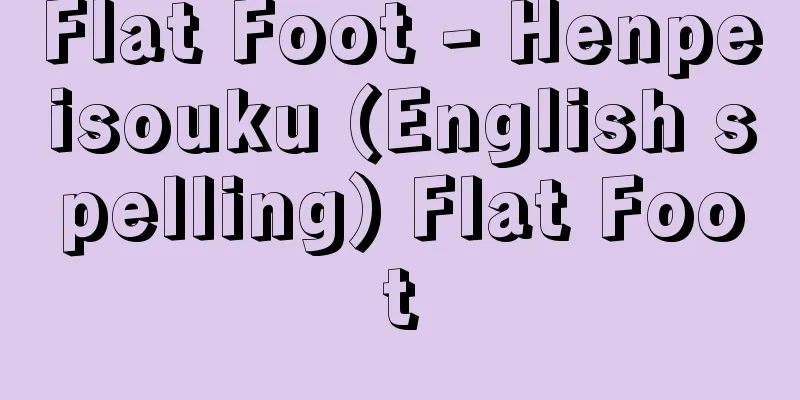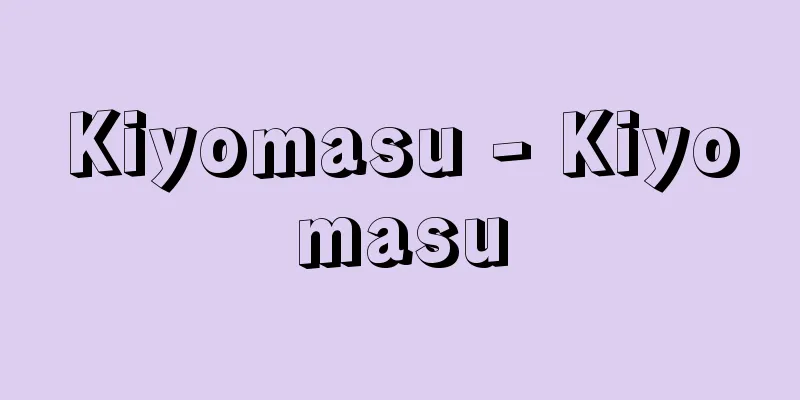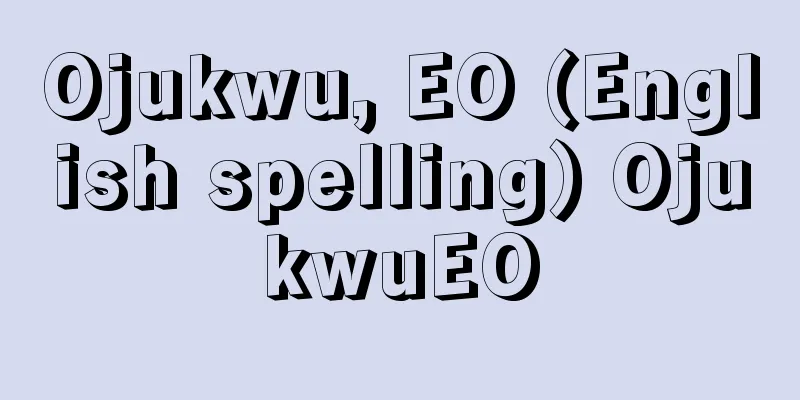Flat Foot - Henpeisouku (English spelling) Flat Foot

|
[What kind of disease is it?] There is an arch on the bottom of the foot (front and back arch), which acts like a spring to support your body weight when you stand or walk. Flat feet is when the arch is gone and the entire sole of the foot is flat. When you look at the foot from behind, the heel is curved outward (eversion). For this reason, orthopedic surgeons call this deformation flatfoot valgus. Children have flat feet because the ligaments connecting the bones of the foot are too soft (joint laxity), meaning the foot cannot withstand the child's weight, causing deformation. Therefore, when lying down, the foot returns to its normal shape and an arch is visible. In adult flatfoot ("pes planus"), the deformity is fixed and rigid and is quite different from childhood flatfoot. [Symptoms] When you stand, the inside arch of your foot drops, and when viewed from behind, your heel turns outward relative to your calf (eversion). The front of your foot turns outward relative to your heel (abduction). When an X-ray is taken of the foot while in a standing position, it is clear that the bones of the foot (tarsus) are not deformed, but their arrangement is flattened and there is no arch. The feet of infants and young children are plump and have an abundance of fatty tissue on the soles, so at first glance they may appear flat, like flat feet. However, X-rays often show normal results, so care must be taken when diagnosing. In addition, it is difficult to accurately evaluate the arch of a child's foot using the method of applying ink to the sole and then examining the condition of the arch using a printout. Young children with flat feet are prone to falls because of loose joints and may complain of leg pain at night, but their legs do not hurt when they walk. When you enter junior high school and your body is still developing, standing for long periods of time, such as during morning assemblies, can cause fatigue and pain in your legs. [Treatment] The arch of a child's foot is low at first, but gradually becomes higher as they grow between the ages of 3 and 5. Therefore, for young children with flat feet, we have them play barefoot on grass or dirt and practice walking on their tiptoes to strengthen the foot muscles, and we observe the progress until they are about 5 years old. Also, choose shoes with a hard heel area to prevent the heel from turning outward. For children with severe deformities who are thought to have unstable walking, or for children who show no improvement during monitoring, orthotics such as corrective shoes and insoles (arch supports) are used. In any case, flat feet are not something that can be cured quickly, so it is important to continue to pay attention until your child's feet begin to stiffen in the latter half of elementary school. Only flat feet caused by nerve paralysis require surgery. Flat FootThe sole of a person's foot is made up of bones, ligaments, and muscles that form an arch structure. This arch is made up of two vertical arches on the inside and outside, and a horizontal arch at the front of the foot. These arches act like springs to absorb shock when walking. When there is an abnormality in the mechanism that forms the arch, the arch collapses and the arch of the foot disappears. This is called flat feet. [Symptoms] Flat feet cannot absorb the shock of walking, so the main symptoms are pain and fatigue in the feet, but pain can also occur in the thighs, lower legs, and lower back. However, some people with flat feet do not experience any symptoms. [Cause] There are various causes, including congenital, traumatic, inflammatory, paralytic, and static flat feet, but the majority of cases are caused by weak ligaments and muscles that support the arch (static). [Treatment] Flat feet in children occurs when the muscles, ligaments, and bones are still immature, and in most cases will improve naturally as the child grows. For conditions that occur after school age as a result of sports or standing for long periods of time, or that occur due to obesity or muscle weakness in middle age, foot support with a longitudinal arch can be used and exercises can be performed to strengthen the muscles that support the arch of the foot. Source: Shogakukan Home Medical Library Information |
|
[どんな病気か] 足の裏側には、土踏まず(前後のアーチ)があり、立ったり歩いたりするときに、体重を支えるバネのような役目をしています。 扁平足は、土踏まずがなくなり、足の裏全体が平らになっている状態をいいます。 足をうしろからみると、かかとが外にそっています(外反)。このため、整形外科では、この変形を外反扁平足(がいはんへんぺいそく)といいます。 子どもの扁平足は、足の骨を連結している靱帯(じんたい)がやわらかすぎて(関節弛緩(かんせつしかん))、自分の体重に足が耐えられず、変形がおこるものです。 したがって、寝た姿勢では正常の足の形にもどり、アーチがみられるのが特徴です。 おとなの扁平足(「扁平足」)では、変形は固定されていてかたく、子どもの扁平足とはまったくちがいます。 [症状] 立ったとき、足の内側のアーチ(土踏まず)が下がり、うしろからみると、かかとが、ふくらはぎに対して外にそっています(外反)。足の前方は、かかとに対して外に向いて(外転)います。 立った姿勢で足のX線写真を撮ると、足の骨(足根骨(そくこんこつ))の変形はないのですが、その配列が平らになって、アーチがなくなっていることがわかります。 乳幼児の足はふっくらしており、足裏の脂肪組織が豊富なため、一見すると扁平足のように平らに見えますが、X線写真では正常なことが多いので、診断には注意が必要です。 また、足裏に墨(すみ)を塗って、そのプリント像で土踏まずの状態を検査するやり方では、子どもの足のアーチを正確に評価するのは困難です。 扁平足の幼児は、関節がゆるいために転びやすく、夜間に脚(あし)の痛みを訴えることがありますが、歩いているときに脚が痛いということはありません。 中学生になって、からだができあがるころに、朝礼などで長い間立っていたりすると、脚のだるさや痛みがおこることがあります。 [治療] 子どもの足の土踏まずは、初めは低いのですが、3~5歳までに、成長とともにしだいに高くなっていきます。 したがって、幼児の扁平足では、裸足(はだし)で芝生や土の上で遊ばせたり、爪先(つまさき)歩きの練習をさせたりして、足の筋肉を鍛えながら、5歳くらいまで経過を観察します。 また、靴は、かかとの外反を防ぐため、かかとの入る部分がかたいものを選びます。 変形が強く、歩行が不安定と思われる子どもや、経過を観察していて改善がみられない子どもは、矯正靴や靴の中敷(アーチサポート)などの装具を使用します。 いずれにせよ、扁平足はすぐに治るものではなく、子どもの足がかたまってくる小学生後半までは、注意することがたいせつです。 手術が必要になるのは、神経のまひが原因である扁平足だけです。 へんぺいそく【扁平足 Flat Foot】人の足の裏は、骨や靱帯(じんたい)、筋肉によってアーチ構造を形成しています。このアーチは、内側と外側の縦方向の2つのアーチと、足の前方の横方向のアーチの3つからできています。これらのアーチは、歩行時の衝撃を吸収するスプリングのようなはたらきをしています。 アーチを形成するメカニズムに異常がおこると、アーチがくずれて、土踏まずの部分がなくなってしまいます。これを扁平足といいます。 [症状] 扁平足では、歩行の衝撃を吸収できないので、おもに足の痛みや疲労感が出ますが、大腿部(だいたいぶ)(太もも)や下腿(かたい)(膝(ひざ)から足首まで)、腰にも痛みがおこることがあります。しかし、扁平足でも症状が現われない人もいます。 [原因] 先天性、外傷性、炎症性、まひ性、静力学性など原因はいろいろありますが、大部分はアーチを支えるべき靱帯や筋肉が弱いためにおこる(静力学性)扁平足です。 [治療] 小児期の扁平足は、筋肉や靱帯、骨などが、まだ未熟なためにおこるもので、ほとんどが成長にともなって自然に治ります。 学童期以降にスポーツや長時間の起立がきっかけでおこったものや、中年期の肥満や筋力低下にともなっておこったものは、縦アーチをつけた足底板(そくていばん)を使ったり、足のアーチを支える筋肉を強化する運動を行ないます。 出典 小学館家庭医学館について 情報 |
>>: Condyloma flatus - Hempeikonjiro-ma
Recommend
Shimi (silverfish) - Shimi (English spelling) silverfish
A general term for insects belonging to the order ...
Hajime Motoda
A politician of the Meiji, Taisho and Showa perio...
Chelyabinsk (English spelling) Челябинск/Chelyabinsk
A large industrial city in the Urals, central Rus...
Knitwear
A general term for clothing made from knitted fabr...
Mother and Child Welfare, Widow Welfare - Boshi Fukushi Kafu Fukushi
This policy aims to promote the welfare of single-...
Array Antenna - Are-Antenna
...In addition to these, a wide variety of antenn...
Ostende Company - Ostende Gaisha (English name) Ostendische Handelskompanie
A trading company founded in Ostend in the Austria...
Hong Gai - Hong Gai (English spelling)
The capital of Quang Ninh Province in northern Vi...
Badakhshan - Badakhshan (English spelling)
The name of a region in northeastern Afghanistan. ...
Hanging tag - Kakefuda
...It is a method of communicating rules and laws...
Scirpus maritimus (English spelling) Scirpus maritimus
...A perennial plant of the Cyperaceae family tha...
Kyochou - Kyochou
…General term for birds of the family Dinornithid...
Tinkering - Ikake
This technique involves injecting molten metal int...
Tadogra
… The mountain range is home to many prehistoric ...
Ultrafiltration (Ultrafiltration)
Colloidal particles cannot be separated from collo...









